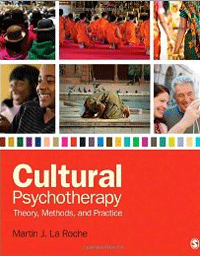“Cultural Psychotherapy: Theory, Methods, and Practice”

“Cultural Psychotherapy: Theory, Methods, and Practice”
By Martin J. La Roche
Sage Publications
Los Angeles, CA, 2013
Thoughtful work may help practitioners boost cultural competence
Reviewed by Paul Efthim, Ph.D.
My introduction to cultural matters in therapy came during graduate school in the late 1980s. Although our capable professor took a nuanced approach to the subject, the reading was woefully simplistic. I still can recall how our textbook lumped people into ethnic and cultural categories, described differences between the groups, and then prescribed recipes for how to relate to these “others” based on these often stereotyped notions.
I was pleased to see how times have changed when I opened an ambitious new text, “Cultural Psychotherapy” by Boston psychologist Martin La Roche. Rather than focusing on between-group differences or designing specific interventions targeted for narrow groups, La Roche seeks to incorporate a broad range of cultural considerations into how we think about psychological treatment.
La Roche writes from a perch in academic medicine: he is a Latino American psychologist who holds a teaching appointment at Harvard Medical School, sees patients and supervises in an urban outpatient clinic run by Children’s Hospital and also maintains a private practice in Cambridge. He proudly (and accurately) notes that his ideas flow from his experience working with a more diverse patient population – poor, ethnic minority, often living in dangerous neighborhoods – in contrast to other cultural models developed by psychologists based in university counseling centers and other less gritty settings.
At the crux of La Roche’s “cultural psychotherapy” approach is a three-phase model that suggests how and when to incorporate cultural and contextual factors into the treatment process over time. Phase I focuses on individual factors: patients’ chief complaints, symptoms and basic needs. Once those have been addressed sufficiently, work in Phase II moves toward relational factors: enhancing patients’ ability to develop fulfilling relationships, using the therapeutic relationship as a vehicle. Finally, in Phase III contextual factors move into the foreground: helping empower patients to comprehend and transform their sociocultural contexts.
The author emphasizes that in accordance with the three-phase model, clinicians may need to delay overt discussions about cultural factors until initial goals around symptom reduction have been at least partially achieved. A number of case examples illustrate possible trouble spots in the timing and handling of taking up culturally-relevant phenomena. Additionally, La Roche devotes an entire chapter to the importance of fostering patient empowerment in a variety of culturally relevant ways. Other chapters discuss how to deal with cultural differences in the treatment process, how to incorporate cultural thinking into our clinical formulations and progress in developing culturally competent interventions.
The author shows how some treatment approaches that appear universally applicable (for example, relaxation training) may carry subtle cultural loadings that can be an obstacle to treatment. He tells the story of an Asian patient who has a negative reaction to being asked to visualize herself alone on a beautiful beach. Being alone is a fantasy that sits well with Western ideals of individualism; this patient, however, noted that imagining being with family members was much more associated with relaxation for her. Treatment could proceed only after the guided imagery was modified to include important others in the scene.
This book benefits from numerous case illustrations as well as from La Roche’s admirable willingness to share his mistakes in the service of teaching about common problem areas. He incorporates a wide variety of theoretical perspectives and does not shy away from tackling sophisticated questions around the intellectual and philosophical paradigms that underlie our work. The emphasis on practical “how-to” helps the text remain accessible to students although it can feel at times overly prescriptive and rule-oriented. La Roche is fond of using mathematical equations and scientific metaphors which will probably be useful for some readers but perhaps confusing for those not comfortable in that cultural terrain.
Well-written, thoughtful, and borne from years of hard-won clinical wisdom, “Cultural Psychotherapy” is recommended for masters- and doctoral-level instructors, early-career clinicians and more experienced practitioners who seek help with the nuts and bolts of increasing their cultural competence.
Paul Efthim, Ph.D. is a licensed psychologist in private practice in Brookline, Mass. He holds a faculty appointment at the Boston Institute for Psychotherapy and is a candidate at the Massachusetts Institute for Psychoanalysis.
Learn more about the book: Cultural Psychotherapy: Theory, Methods, and Practice
